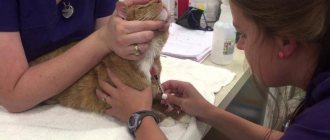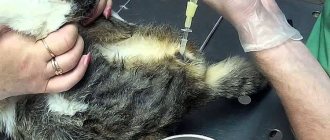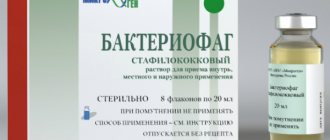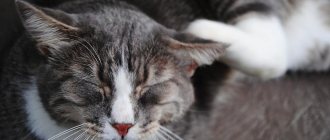Home » Cats » Cat health » Creatinine in the blood of cats: what is it and how to deal with it?
When a furry pet appears in the house, in addition to questions about what tasty things to feed it and how to play with it, questions arise about its health and how to keep it in proper shape. Creatinine in the blood of cats is one of the pressing problems for many four-legged friends. Let's try to understand what it is, what its norm is, which is why its level may increase or decrease.
Content standards
This substance is formed in the animal’s body from the protein creatine, which is a source of energy and nutrition for skeletal muscles. The normal level of its content in the blood can fluctuate depending on the weight of the cat and the speed of metabolic processes occurring in its body. In young and active animals this indicator is usually higher than in old ones.
The normal level of creatinine in the blood of domestic cats is 40-130 µmol/liter. This indicator, among other things, may depend on the sex of the animal and the development of its muscle mass.
What is it and what is the norm for cats?
During nitrogen metabolism in the cat's body, end products are formed, in particular creatinine. In a healthy pet, it comes out along with urine, but if some pathological changes occur, then its level in the blood increases. Creatinine is formed from creatine protein, which serves as a nutrient for skeletal muscle. During normal contraction of muscle fibers, the components break down into creatinine, water and phosphorus. Subsequently, the products are excreted through the kidneys and urinary system.
Veterinarians claim that the average daily creatinine level in young and active cats is higher than in adults and sedentary cats.
The norm of creatinine in cats is in the range of 40-130 µmol/liter. During laboratory blood tests, indicators may deviate upward or downward. This does not always indicate pathology, provided that the pet feels well. The following factors may distort the results:
If your pet is overweight, this factor may affect the results of the study.
- problems with excess weight;
- lack of energy or plastic components in the cat’s body;
- the pet is too young or mature;
- dietary food in which the cat receives little protein.
In what cases does the level increase?
Most often, the presence of too much of this substance in the animal’s blood indicates renal failure or nephropathy. The creatinine-phosphate reaction occurs when the cat's muscles contract. In this case, the connection breaks down into three components:
- water;
- creatinine;
- phosphorus.
All three components are subsequently excreted from the animal’s body in urine. If the kidneys are not working well, creatinine is retained in the cat's body. Gradually, it begins to accumulate in the animal’s blood.
However, it is impossible to diagnose renal failure only by such a sign as increased creatinine in a cat. If such a pathology is suspected, the veterinarian conducts additional laboratory tests. In this case, the specialist determines the level of urea and urea nitrogen in the blood. In the presence of renal failure, these indicators will also go off scale.
Sometimes the cause of elevated creatinine in a cat’s blood is also some kind of liver problem. In addition, such a pathology in an animal can also occur when the body is dehydrated. In this case, the cat’s urine density additionally increases.
Actually, creatinine itself is not a toxic substance. An animal feels unwell when it is kept at high levels precisely because of problems with its internal organs.
Normal and abnormal levels of creatinine in the blood
X-ray of kidney failure in a cat
At the very beginning, creatine “enters” the animal’s body in company with protein products of animal origin. It can be synthesized in his body from just three amino acids: arginine, glycine and methionine.
Synthesis occurs in two stages - in the kidneys and in the liver. But then, with the blood flow, this breakdown product “comes” to the nervous tissue and muscles, where it is converted into creatine phosphate. The muscles really need the latter in order to generate energy when performing any physical activity. Nerve tissue cells also need it to maintain viability if there is a lack of oxygen. This is where creatine phosphate breaks down in this way: creatinine is formed and the necessary energy is released.
At any stage of metabolism, personal characteristics of the disorder can lead to fluctuations or a persistent increase in the level of creatine in the animal’s blood.
How much creatinine is in the blood of cats? It depends on the age of the animal, its body weight, gender, how developed its muscles are and even its character.
The normal level of creatinine in the blood of cats is creatinine 40 - 130 µmol/liter. These numbers may vary somewhat among different laboratories.
Increased in renal failure
If a pet is diagnosed with kidney failure, then increased creatinine in the blood of cats is observed. If it rises to 200 µmol/liter, then this will not affect the appearance of the animal in any way. When creatine is more than three hundred micromol/liter, the cat’s general condition very quickly becomes worse. And if creatinine exceeds six hundred micromol/liter, it is very difficult to bring the animal back to normal.
Other cases of increased creatinine in the blood
Quite often, elevated creatinine in the blood of cats indicates renal failure or various nephropathies. But to make a final diagnosis, creatinine values alone are not enough. It is necessary to examine the animal very carefully. If it is still kidney failure, then both urea and urea nitrogen levels will be high. Then you just need an x-ray or an ultrasound result.
By the way, there are other options for increasing creatinine. For example, the problem may be in the liver. In addition, high creatinine in a cat’s blood is a consequence of dehydration. At the same time, the density of urine increases.
The pet owner should pay attention to the following symptoms: the animal is rather lethargic and weak; diarrhea or vomiting may begin; urine output may decrease or stop completely; appetite decreases sharply; there is an unpleasant odor of urine from the animal’s mouth; mucous membranes are pale.
Cases of decreased creatinine in the blood
Pet owners are concerned about how to reduce creatinine in a cat’s blood? Here you need to know that a decrease in its formation occurs against the background of severe exhaustion and a decrease in muscle mass.
This also occurs with polyuria and polydipsia. A significant amount of fluid and creatine is removed from the animal's body. But if there is renal failure, then a decrease in creatinine is not observed.
Treatment of fluffies is carried out in accordance with the diagnosis. But in any case, therapy should be started as early as possible. The veterinarian will give instructions and prescribe medications. All his recommendations and advice should be followed “from start to finish”, following the instructions provided.
If it suddenly turns out that the disease is in an advanced stage, the veterinarian may suggest hospitalization of the animal. In this case, even droppers and drugs that can support the renal functions of a four-legged patient can be prescribed. Medicines will also be needed to normalize water balance and metabolism.
In any case, you should know that the doctor will only help relieve the animal’s acute illness. Unfortunately, it will not be possible to completely rid the animal of the disease.
Diagnosis of diseases: what should be considered?
The reasons for increased creatinine in the blood of cats can be different. But the level of this substance in an animal’s body can be affected by the following factors:
- obesity;
- severe deficiency of energy substances in the body;
- diet low in calorie foods;
- deviations in weight for this particular breed;
- extreme marks of the animal's age.
When diagnosing a cat’s health condition and determining its creatinine level, all these factors must be taken into account.
Origin of creatinine
Structure of creatinine
Creatinine is the end product of protein metabolism, the creatine-phosphate reaction. In the body, it is formed when creatine phosphate breaks down. It can form in the muscles and then be released into the blood. It takes a very active part in the energy metabolism of tissues, including muscles. The kidneys help remove it from the body through glomerular filtration. It's because of this
They are trying to find out how much creatinine is in the blood of cats, because this is a very important indicator of how the animal’s kidneys work.
It is important to note that knowing what the level of creatinine is will help diagnose many diseases and pathological conditions of the furry. Despite the fact that there is a direct connection between its amount in the blood and the functional capacity of the kidneys, fluctuating readings from the boundaries of the established norm are not always associated with the fact that there is some pathology of the animal’s kidneys.
You should know that the metabolism of this metabolic product consists of several stages. Violations in each of them can cause pathological changes.
Symptoms
When the level of creatinine in the blood increases to 200 µmol/liter, the animal’s behavior most likely will not change in any way. The cat’s condition will begin to deteriorate after this indicator reaches 300 µmol/liter. If creatinine is elevated, the cat may experience the following symptoms:
- lethargy and weakness;
- diarrhea and vomiting;
- pallor of mucous membranes;
- stopping urination or reducing the volume of urine produced;
- decreased appetite.
A cat with high creatinine levels usually has an unpleasant smell of urine from his or her mouth.
The level of this substance in the blood of animals can be determined not only in micromol/liter. Sometimes it happens, for example, that owners are interested in whether a cat has a chance with a creatinine of up to 1500 mg/dl. This level corresponds to 250-300 µmol/liter. Since creatinine is not a very accurate indicator, it is still premature to talk about the development of PN in this case. The cat's blood should first be checked for urea content. Perhaps this indicator is associated with dehydration or liver pathology.
The prognosis for a cat with a creatinine of 1200 mg/dL may also not be too bad. This level indicates a relatively insignificant increase in this substance in the body. But it is imperative to diagnose renal failure in this case as well.
What you need to know
Sometimes the creatinine level in a cat's blood remains normal. But a disease such as kidney failure still develops in the animal. This usually happens when a cat, for example, picked up on the street, is too exhausted. With insufficient feeding, animals can experience a sharp decrease in muscle mass. As a result, the level of creatinine in the blood also drops. In case of renal failure in such an animal, the amount of this substance will be close to normal. But in fact, the creatinine content for such a state of the animal can be considered elevated in this case.
Disadvantages of diagnostics
Normally, a cat’s blood creatinine should be 40-130 mmol/liter. But unfortunately, this indicator for such pets can actually fluctuate within very wide limits. In addition to the weight and activity of the pet, it can be influenced by the nature of the diet, breed characteristics, etc. In addition, the sensitivity of creatinine itself as an indicator of the state of the excretory system is considered not too high. Even with a 50% decrease in kidney filtration due to pathology, the level of this substance in the blood can remain almost normal.
Urea indicators
As already mentioned, if a cat’s creatinine is elevated and kidney failure is suspected, doctors often conduct additional laboratory tests. Urea levels for cats are considered normal at 6-12 mmol/liter. If its content is increased, the animal will experience, among other things, the following symptoms:
- lethargy and weakness;
- unsteadiness of gait;
- ammonia odor from the mouth;
- mouth ulcers;
- weight loss;
- refusal of food.
What to do if the content is high
The level of creatinine in the blood of cats is determined, of course, only in a veterinary clinic. In accordance with the results obtained, the doctor gives the animal owner all the necessary recommendations and, if necessary, prescribes additional tests. It is necessary to do research on the percentage of urea in the blood if a cat has high creatinine. Kidney failure is a very serious disease. And, of course, it is not worth leaving an animal without medical care in the presence of such a pathology.
Clinical signs
- Anorexia, depression
- Vomiting due to hyperacid gastritis, polydipsia, polyuria. Gingivitis with ulcers on the tip of the tongue. Anemic mucous membranes. Secondary hyperparathyroidism with softening of the bones of the facial skull is observed.
- Constipation, dehydration
- Upon palpation, you can detect a change in the size of the kidneys; most often they are reduced; if chronic renal failure is caused by amyloidosis, hydronephrosis, tumors, an enlargement of the kidneys is observed.
- Uremic encephalopathy: coma, tremor, epileptiform seizures, teteany.
- Arrhythmia bradycardia. Increased blood pressure, hypertrophy of the left half of the heart. Acidosis causes deepening of breathing.
- Immune depression, soft tissue calcification, bleeding disorders, insulin resistance (increased blood glucose levels), pancreatic dysfunction (hyperamylasemia). Thinning hair, poor coat quality.
- Lethargy is observed in cats with end-stage chronic renal failure.
Diagnostics
CRF can be diagnosed in an animal by clinical symptoms, but they can also be non-specific, because Depression, lethargy, lack of appetite and weight loss are observed in many diseases. Laboratory tests are required to confirm the diagnosis. In our clinic, we most often use biochemical and clinical blood tests and urine tests, and in many cases we perform ultrasound examination of the kidneys.
Blood chemistry
Elevated levels of urea, urea nitrogen and creatinine are determined. The determination of creatinine in the blood is more important than the determination of urea, because the level of creatinine is not influenced by diet or the level of protein breakdown.
You can also determine the glomerular filtration rate: the volume and concentration of creatinine in urine per day is determined and correlated with the level of creatinine in the blood serum.
Symptoms of lack of appetite are observed when the urea level is more than 25 mmoll; when the urea content is 40 mmoll (the norm is 5-10 mmoll), the animal will experience severe depression and anorexia.
Insufficient excretion of limiting phosphorus leads to an increase in its level in the blood, while the calcium level falls (with moderate chronic renal failure, the phosphorus level is no more than 2.1 mmoll, with severe chronic renal failure more than 3.2 mmoll).
The release of calcium from bones when phosphorus levels are high leads to soft tissue mineralization. Most cats with chronic renal failure exhibit hyponatremia or hypokalemia, hypoalbuminemia, and hyperamylasemia. Non-regenerative anemia, hypokalemia. Isosthenuria, urine density 1008 and below.
Clinical blood test for cats and dogs
The following picture prevails: non-regenerative anemia caused by a decrease in the production of erythropoietin by the kidneys and a decrease in the lifespan of circulating red blood cells, leukocytosis with lymphopenia and thrombopenia.
Animal urine analysis
Isosthenuria (osmolarity is usually below 1015), pH changes to the acidic side, proteinuria, inactive urinary sediment, rarely glycosuria.
Ultrasonography
Increased echogenicity of the renal parenchyma, blurring of the boundaries of the cortical and medial layers, reduction in the size of the kidneys.
X-ray examination
A decrease in the size of the kidneys is determined to be less than 2.5 times the length of the body of the second lumbar vertebra (L-2). If overt hyperparathyroidism is observed, a decrease in bone density, especially in the maxilla, and soft tissue calcification are visible.
Cat blood test: explanation
Veterinarians usually conduct tests on the level of creatinine in a cat’s blood in case of suspected kidney disease. If the cause of the animal’s illness is still unclear, the clinic performs a comprehensive analysis. Its decoding usually looks like this:
- HCT - hematocrit. An excess of this substance can signal dehydration of the animal’s body or, for example, the development of diabetes mellitus. The normal level of this substance in a cat’s blood is 24-26%;
- HGB - hemoglobin. An increased level indicates dehydration, a decreased level indicates anemia, damage to the hematopoietic organs, and starvation. The normal level of hemoglobin in a cat’s blood is 80-150%.
- WBC - white blood cells. An increase in readings may indicate leukemia, inflammation, oncology; a decrease may indicate a viral disease, bone marrow disease, or radiation damage. The normal leukocyte level for cats is 5.5-18.0 × 109/L.
- RGB - red blood cells. Elevated levels may indicate dehydration, lack of oxygen and, in some cases, kidney and liver disease. A reduced content indicates blood loss, anemia, and inflammation. Normal level is 5.3-10×1012/l.
- ESR is the erythrocyte sedimentation rate. An increase in level may indicate liver and kidney disease, heart attack, oncology, poisoning, shock. There is no such thing as a low ESR. Normally, this figure is 0-13 mm/h.
Also, when performing laboratory tests, the animal’s blood can be checked, for example, for indicators such as eosinophils, neurophils, monocytes, platelets, lymphocytes, etc. Poor blood tests in a cat are, of course, a reason to diagnose the disease and prescribe appropriate treatment.
Biochemical analysis of cat urine - conflicting results
Anonymous user
544 views
April 22, 2020
Hello! I have a sterilized Siberian cat, age 6 years and 4 months, weight 5.5 kg. The cat lives only in the apartment and never goes outside. I feed my cat high-quality dry grain-free food for sterilized cats “Gosbi Original Cat Grain Free Sterilized” (Spain) and canned food for sterilized cats from this manufacturer. This food has a low protein content of 32% (which is less, for example, than ProPlan food for sterilized cats, which has 41% protein). Gosbi food is free of grains, corn and wheat gluten and consists of natural ingredients, including algae, fruits and vegetables rich in natural antioxidants. In accordance with the feeding standards specified by the food manufacturer, as well as age and weight, the cat is given a minimum amount of food, which the cat, as a rule, does not eat completely, which indicates that the cat is not overfed. Also, once a day, along with food, according to the recommended norm, the cat is given Beaphar Malt Paste for hair removal (manufactured in the Netherlands). Regarding the cat’s drinking water, I can explain that (surprisingly), compared to the cats of my friends and relatives, my cat, so to speak, even drinks water with pleasure. In addition to the fact that her water is always fresh, containers with water are placed in the rooms of the apartment, the cat periodically drinks water on her own, so I also supplement the cat with water, bringing her a container of water in the evening (before bed), in the morning and during the day. Therefore, it seems to me that the cat consumes a sufficient amount of water. In my opinion, the cat's urination is normal. In a small way, she walks 2 - 3, and sometimes 4 times during the period from 6.00 to 24.00 hours. In general, a cat usually walks 2 times during the specified period. The cat's behavior is normal - no different from usual, stool and urination are normal. There is constant access to fresh water. I constantly monitor the cat’s health – we periodically take urine tests (general and biochemical); stool analysis, including parasitological examination; blood tests (general and biochemical); SDMA analysis, ultrasound. Regarding the findings of the ultrasound, I can explain that the last time an ultrasound of the abdominal cavity was performed was in the fall of 2021 (unfortunately, I cannot indicate the date, since the results were not found), but before this ultrasound was performed on March 20, 2019, and the results, as I remember, were the same, namely: “moderate hepatosis, impaired renal function, chronic cystitis.” The same results were indicated earlier, even when all the tests in the cat were normal. I can’t say anything bad about the doctor who performed the ultrasound (and this is not the place to evaluate the doctors’ performance or criticize), but it seems that the text of the ultrasound study is always practically the same, and is written as if according to a template. At least, the above conclusion was present both when the cat did not have any deviations from the norm in the tests, and when there were any. Previously (2 years ago), when the cat was fed ProPlan food for sterilized cats (dry and canned), unorganized sediment (single tripel phosphates) systematically began to appear in the cat’s urine and also, at the same time, the level of protein in the urine sometimes increased. Because of this, temporarily (from 2 weeks to 1 month) it was necessary to feed the cat Purina UR medicinal food (dry and canned), as a result of which tripelphosphates disappeared, and the level of protein in the urine returned to normal. The use of Gosbi has eliminated intermittent problems with loose sediment (single tripel phosphates), but urine protein levels are still sometimes higher than normal. QUESTION: Based on the test results below, I ask you to inform me about the supposed reasons for the excess of such important indicators as urine urea, urine creatinine, urine protein and others from the norm against the background of the fact that such important indicators as SDMA, protein ratio are normal /creatinine and urine urea/creatinine ratio (in urine biochemistry), as well as all indicators of a biochemical blood test. I also ask you to inform me about the possible reasons for the excess and decrease (compared to the normative ones) of some indicators of the clinical (general) blood test given below. Are deviations from the norms of some indicators of fundamental importance if they are insignificant? Is it acceptable to use “Purina UR” to lower the level of protein in a cat’s urine, given that previously the use of this medicinal food for from 2 weeks to 1 month normalized the level of protein in the urine along with the removal of unorganized sediment (single tripel phosphates ) and also taking into account the fact that at the moment there is no unorganized sediment and single tripel phosphates? During the next test on March 11, 2020, almost all the indicators of the above tests are normal, with the exception of the following: Clinical (general) urine test: Urine protein (semi-quantitative determination) = 300 mg/dl (with a norm of no more than 30). ? Relative density according to the refractometer (RD) = 1.056 g/cm3 (normal!) pH = 6.5 pH units (normal!) Other indicators are also normal. Biochemical urine analysis: Urea urine = 1512.3 mmol/l (with the norm not exceeding 312)? Excess by 4.8 times. Urine creatinine = 44.8 mmol/l (with the norm not exceeding 25)? Excess by 1.8 times. Urine protein (quantities) = 47 mg/dl (with the norm not exceeding 30)? Excess by 1.6 times. Protein/creatinine ratio = 0.09 (normal!) Urine urea/creatinine ratio = 33.73 mmol/l (normal!) SDMA study = 12 mg/dL (normal!) (average for species 0 -14) Biochemical blood test (all indicators are normal!): Total bilirubin (TBil) = 4.5 µmol/l (normal < 10 µmol/l). Direct bilirubin (DBil) = 3.2 µmol/l (normal < 5.5 µmol/l). ACT (GOT) = 22 U/l (normal 12-45 U/l). ALT (GPT) = 29 U/l (normal 18-60 U/l). Ritis coefficient = 0.7 (norm 1.1 – 1.3). Urea (Urea) = 5.9 mmol/l (normal 5.4 – 12.1 mmol/l). Creatinine (Creat) = 123 µmol/l (normal 70 – 165 µmol/l). Total protein (Prot, total) = 76 g/l (normal 57 – 78 g/l). Albumin (Alb) = 41 g/l (normal 24 – 38 g/l). Excess by 3 g/l. Alkaline phosphatase (ALP, IFCC) = 49 U/l (normal < 55 U/l). Alpha-Amylase, total (α-Amylase, total) = 901 U/l (normal 500 - 1200 U/l). Glucose (Glu) = 4.7 mmol/l (normal 3.3 – 6.8 mmol/l). LDH (LDH, IFCC) = 68 U/l (normal 35 - 500 U/l). Phosphorus (Phosphate, inorg) = 1.48 mmol/l (normal 1.10 – 2.30 mmol/l). Albumin/globulin (A/G Ratio) = 1.18 calculated g/l (normal 0.70 – 1.40 calculated g/l). Globulin (Glob) = 35 g/l (normal 29 – 55 g/l). Urea/Creatinine ratio (B/C Ratio) = 25.4 mg/dl (with azothermia: > 30 pre-/postrenal; < 20 renal A. or other reason) Clinical (general) blood test: All indicators are normal, for with the exception: Hematocrit (Hct, PCV) = 55.1% (with an average norm for the species of 29 - 48%), an excess of 7.1%. Hemoglobin (Hgb) = 183 g/l (with an average norm for the species of 90 – 150 g/l), an excess of 33 g/l. Red blood cells (RBC) = 11.6 x10¹²/l (with an average norm for the species of 5.6 - 10.0 x10¹²/l), an excess of 1.6. Leukocytes (WBC) = 2.9 x10 9 /l (with an average norm for the species of 5.5 - 18.5 x10 9 /l), below the norm by 2.6 x10 9 /l)?. Eosinophils (Eos) = 9% (with an average norm for the species of 0 - 6%), an excess of 3%. ? Corrected (true) leukocytes = 2.9 x10 9 /l (with an average norm for the species of 5.5 - 18.5 x10 9 /l), below the norm by 2.6 x10 9 /l)?. Segmented neutrophils ABS = 1.65 x10 9 /l (with an average norm for the species of 2.50 - 12.50 x10 9 /l), below the norm by 0.85 x10 9 /l)?. Lymphocytes ABS = 0.93 x10 9 /l (with an average norm for the species of 1.50 - 7.00 x10 9 /l), below the norm by 0.57 x10 9 /l)?. When the tests were repeated a month later, on April 18, 2020, approximately the same results were obtained as previously, on March 11, 2020. At the same time, some indicators that deviate from the norm have changed slightly, namely: Clinical (general) urine analysis: Urine protein (semi-quantitative determination) = 100 mg/dl (with a norm of no more than 30). ?. In March 2021, this figure was 300 mg/dL. Relative density according to the refractometer (RD) = 1.072 g/cm3 (at a norm of 1.036 – 1.060 g/cm3), an excess of 0.012 g/cm3. pH = 6.0 pH units (normal and decreased compared to March 2020) Other indicators are also normal. Biochemical urine analysis: Urea urine = 1609.9 mmol/l (with the norm not exceeding 312) ? Excess by 5.2 times. Urine creatinine = 44.2 mmol/l (with the norm not exceeding 25)? Excess by 1.8 times. Urine protein (quantities) = 57.2 mg/dl (with the norm not exceeding 30) ? Excess by 1.9 times Protein/creatinine ratio = 0.11 (normal!) Urea/creatinine urine ratio = 36.43 mmol/l (normal!) I really hope to receive a competent, professional answer. Thank you.
The question is closed
No reward
How to lower blood creatinine levels
This indicator is usually brought back to normal with the help of medications. For example, a veterinarian may prescribe treatment using Hofitol if a cat has high creatinine. The drug is human and is sold in regular pharmacies. Most often, these tablets are given to animals 2 times a day, half of them. But, of course, only the veterinarian should prescribe the medicine and choose the dosage.
In case of chronic renal failure, the animal can only be treated symptomatically. The answer to the question of how to lower creatinine in a cat is provided by various types of medications. They are usually prescribed by a veterinarian in combination with other medications that can improve the condition of a pet and prolong its life.
Causes of kidney failure
Actually, PN itself is not essentially a disease. Renal failure is primarily a syndrome of dysfunction of the excretory system. This problem can result from:
- poisoning and intoxication;
- vasculitis, pyelonephritis in the kidney area;
- renal vessel stenosis;
- diabetes mellitus in old cats.
Animals may also have a hereditary predisposition to kidney failure. When buying an expensive cat, you should definitely ask about its pedigree.
Consequences of kidney failure
This pathology must be treated immediately. Kidney failure is a very insidious disease. Creatinine itself is a safe substance. But toxic nitrogenous bases, the content of which also increases during PN in the blood of cats, destroy vitamins and many other useful substances. An animal with renal failure experiences a serious disturbance in the water-salt balance and acid-base state.
In case of severe damage, the endocrine function of the pet’s adrenal glands suffers. The synthesis of glucocorticoids stops in the cat's body. This over time leads to hypocemia and decreased insulin sensitivity, which, in turn, can cause the development of diabetes mellitus.
Prevention
To ensure that your cat’s blood creatinine does not increase, it is recommended to regularly monitor his health. It is important to feed your pet properly and in a balanced manner, not allowing him to eat spicy, fatty or fried foods. A pet's diet should be varied and contain many vitamins and microelements. If the owners decide to feed their cat dry food, then they need to choose it carefully and not skimp, since cheap options contain a lot of dyes and other harmful components that can lead to impaired kidney function. Regular examination of your pet by a veterinarian can help reduce the likelihood of developing kidney failure associated with high creatinine levels. It is worth carrying out a preventive examination of the cat at least once a year, and if the pet is more than 10 years old, then it is recommended to visit a specialist once every six months.
Symptoms of kidney failure
So, the cat's creatinine is elevated. We found out what this means. Of course, such tests usually cause the owner to worry about the condition of the animal’s kidneys. Only a veterinarian can diagnose deficiency. But the owner of the animal, with elevated creatinine readings, of course, needs to observe his pet himself. Symptoms of kidney failure include:
- constant unquenchable thirst;
- increased number of urinations;
- clarification of urine;
- periodic refusals to eat.
Sometimes an animal with PN may experience nausea and vomiting. This sign in itself does not indicate any disease. Cats specifically eat grass and various inedible things to cleanse their stomach. But in combination with other symptoms, this sign may also indicate the presence of PN.
At later stages, symptoms of deficiency may include:
- the cat's inability to swallow food;
- anorexia and dystrophy;
- damage to the nervous system due to toxins;
- the appearance of protein and blood in the animal’s urine;
- itching
Very often, cats with late-stage renal failure have very high blood pressure. And this, in turn, can lead to blindness due to rupture of blood vessels in the eyeball.
Microscopic urine analysis
Microscopic analysis includes:
- identification of epithelium;
- red blood cell detection;
- analysis for leukocytes;
- urinary cylinders;
- microbes;
- salt crystals;
- slime.
Microscopic analysis involves the detection of red blood cells.
Normally, the epithelium can only be squamous. The presence of a transitional type indicates the presence of cystitis, urethritis, and bladder cancer. Renal epithelium - nephritis, poisoning, fever, infection, renal failure.
The urinary sediment should not contain red blood cells.
If the urine is cloudy, alkaline, viscous sediment consisting of neutrophils - cystitis. The environment is acidic, loose sediment, consisting of leukocyte cylinders - nephritis. A high content of lymphocytes – glomerulonephritis.
Cylinders
- Urinary casts are formed from cells, protein and salt, the physiological state is a single quantity.
- The presence of hyaline – kidney damage, poisoning, hyperthermia. Granular – nephrosis, intoxication of the body.
- Waxy - severe pathology.
Urinary casts are formed from cells, protein and salt.
Microbes
There shouldn't be any germs.
There should be no microbes; if they are present, it means there is a disease: pyelonephritis, urolithiasis, frequent use of a catheter, diabetes mellitus.
We suggest you familiarize yourself with: Aquarium equipment - what you need for quality aquarium care
Salt crystals
Salt crystals do not guarantee pathology.
May occur when medications leave the body, hyperthermia, or overexposure to urine before the test.
Mucus in urine
The presence of urethritis, prostatitis, cystitis, pyelitis will indicate the presence of mucus.
Mucus in the urine indicates the presence of cystitis.
Treatment of acute failure
In this case, therapy is usually aimed at correcting electrolyte balance and acid-base disorders. The most common cause of acute renal failure is animal poisoning. Of course, in this case, measures are taken to remove toxins from the pet’s body.
Quite often, in cases of acute renal failure, veterinarians perform a procedure such as dialysis on cats. In this case, the animal's abdominal cavity is cut and a tube containing a special liquid is inserted into it. During the time it is in the cat’s body, toxins from its body pass into this solution. This procedure is prescribed only to animals with serious electrolyte imbalances in the body.
Necessary treatment
In some cases, dialysis for an animal is justified.
If the indicator was inflated only once, and the pet’s condition is normal, then do not worry. In such a case, the disorder soon goes away on its own and no special treatment is required. When blood creatinine in cats is constantly above normal values, it is worth consulting with a veterinarian. After a comprehensive examination and finding out the source of the problem, the specialist will tell you how to reduce the concentration of the substance and stabilize the condition of the pet. In most cases, altered indicators are caused by renal failure, occurring in acute or chronic form. The disease must be treated as soon as possible, since severe intoxication of the cat’s body occurs, which can lead to premature death. In case of exacerbation of kidney failure in a cat, the veterinarian decides to carry out dialysis, through which it is possible to remove toxic substances. The procedure is performed as follows:
- An incision is made in the abdominal wall.
- A tube containing a special liquid is inserted.
- During manipulation, toxic substances go into solution and are removed from the pet’s body.
If the creatinine level exceeds the norm due to acute renal failure, then dialysis is carried out only in case of serious electrolyte imbalance.
Drug therapy
The doctor prescribes erythropoietin to the animal in case of low hemoglobin levels in the blood.
The chronic form of the disease, in which the urinary system does not function properly for a long time, is more difficult to treat. This type of disease cannot be completely cured. The veterinarian prescribes drug therapy, with the help of which it is possible to lower creatinine and eliminate other unpleasant symptoms for a while. The cat needs to take medication for life. Erythropoietin is often prescribed if the hemoglobin concentration is reduced. When acidosis develops against the background of chronic renal failure, sodium bicarbonate is prescribed. In addition to medications, the cat must follow a certain diet, in which special food is recommended that is intended for animals with impaired renal function.
How to treat chronic failure
There is still another way to try to cure the acute form of PN. But most often, chronic renal failure occurs in cats. Unfortunately, this disease is incurable. An animal with such a pathology will most likely have to be given special food and medications for the rest of its life. There are no specific treatment regimens for this disease. In this case, the approach to each animal must be individual.
Treatment of animals with chronic renal failure is symptomatic. For anemia, for example, Erythropoietin can be administered to a cat; for acidosis, sodium bicarbonate is used, etc. In case of intoxication, medications are usually administered to pets through a dropper.
If a cat’s blood creatinine is elevated and he is diagnosed with PN, the owner will definitely have to keep the pet on a special diet prescribed to his pet by a veterinarian. Usually, in case of kidney failure, doctors recommend that the owner of a four-legged pet buy ready-made professional food for him, specially designed for animals with this disease.
It is almost impossible to cure chronic renal failure. But the owner of such a cat is quite capable of alleviating his suffering and improving his quality of life by relieving severe symptoms. In any case, you should not despair and give up at such a diagnosis. You just need to follow the veterinarian’s recommendations exactly, and then the animal will delight its owners with its presence for many years to come.
Diagnostic measures
You should not try to reduce elevated creatinine in a cat’s blood on your own, as this can cause serious complications. At the same time, a home solution to the problem may be ineffective, since without finding out the cause of the pathology, it is not possible to influence it. At the first alarming symptoms, take your pet to a veterinary clinic. Creatinine itself is not dangerous, but it indicates the progression of a serious disease that needs to be treated as soon as possible. To confirm the diagnosis, laboratory testing of whole blood, serum or plasma is required. The veterinarian chooses the diagnostic methods. Material collection is carried out around the clock. If a cat has kidney failure or other diseases of the urinary system, then specialists detect urea and increased creatinine in the blood.











